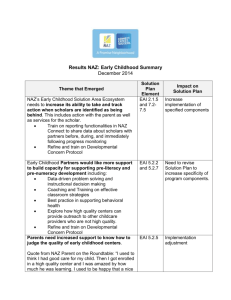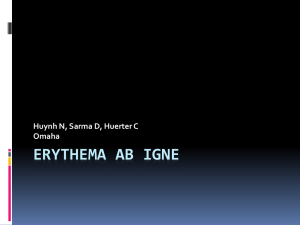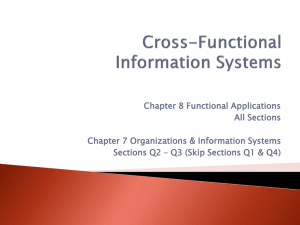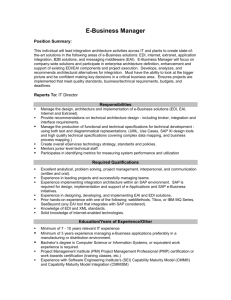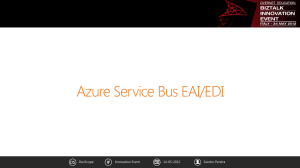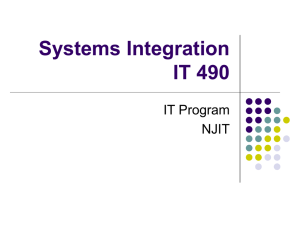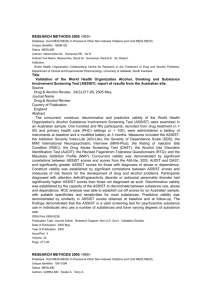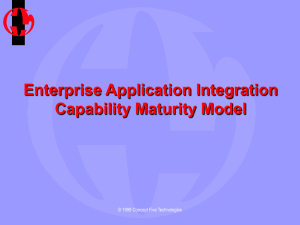Algoritma dan Pemrograman Leon Andretti Abdillah
advertisement
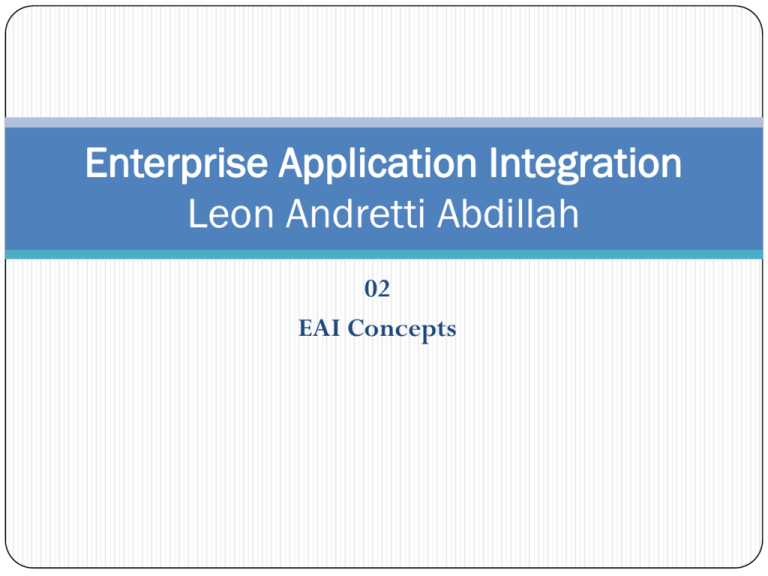
Enterprise Application Integration Leon Andretti Abdillah 02 EAI Concepts Definition 1 Another name is EII (Enterprise Information Integration), BPI (Business Process Integration) BPI: Business Process Integration, or EAI, is a software solution that allows businesses to integrate internal applications, securely connect with business partners over the Internet, and automate business processes. EAI (enterprise application integration) is a business computing term for the plans, methods, and tools aimed at modernizing, consolidating, and coordinating the computer applications in an enterprise. Integrates applications and enterprise data sources so that they can easily share business processes and data. Integration is done without significant changes of applications and data sources [http://girtab.ucc.ie/] 2 Leon Andretti Abdillah - EAI - 02 EAI Concepts 12/11/2013 16:44:54 Definition 2 Enterprise application integration (EAI) is a new label for an old problem, namely that of integrating business systems in order to let them share resources such as data or processes. The severity of this problem becomes more and more apparent with the increasingly complex information systems of modern organisations O. Dahl, "Enterprise Application Integration," School of Mathematics and Systems Engineering, Växjö University, Sweden, 2002. 3 Leon Andretti Abdillah - EAI - 02 EAI Concepts 12/11/2013 16:44:54 Motivations Merger and Acquisition Expansion of inner IS Governments’ trends Cooperation Alliance 4 Leon Andretti Abdillah - EAI - 02 EAI Concepts 12/11/2013 16:44:54 Guiding Principles for Enterprise Integration 5 1. Clear IT Strategy mapped to Business Strategy 2. Mapping of corporate process and data models 3. Plan ahead for EI - investment vs. cost justification 4. Formulate an EI architecture based on integration characteristics 5. Establish clear lines of ownership and accountability 6. Evaluate vendors on commercials, stability, references, strategy 7. Evaluate technologies - scalability, flexibility, customization, standards 8. Invest in the right skills - Solution & Integration Architects 9. Pilot the desired solution, but in a real environment 10. Ensure tools and processes in place for end-to-end service mgmt Leon Andretti Abdillah - EAI - 02 EAI Concepts 12/11/2013 16:44:54 The Integration Problem (i.e. Opportunity) Multiple, disparate applications Custom Legacy Packaged Multiple platforms Multiple databases Multiple transaction processors Multiple data entry points Multiple versions of the same data Incompatible business data William Tse 6 Leon Andretti Abdillah - EAI - 02 EAI Concepts 12/11/2013 16:44:54 Common Applications Targeted for EAI Most large companies use at least several kinds of software and types of data that are candidates for integration: 1. 2. 3. 4. 5. 6. 7. Supply chain management (SCM) Customer relationship management (CRM) Business intelligence and analytics Human resources data Internal and marketing communications Enterprise resource planning (ERP) E-commerce optimization C. Buchholz. (2013) 7 Leon Andretti Abdillah - EAI - 02 EAI Concepts 12/11/2013 16:44:54 Benefits of Enterprise Application Integration Information Sharing 2. Process Automation 3. Reduced IT Complexity 4. Increased Agility 1. C. Buchholz. (2013) 8 Leon Andretti Abdillah - EAI - 02 EAI Concepts 12/11/2013 16:44:55 Information Sharing – EAI enables the flow of information between separate software programs within a company, as well as from outside the company’s own computer systems. EAI can consolidate data collection efforts, eliminating the redundancies of having each application collect and store data for its own purposes. Integration also creates a single point of access to data for the people who need it. That means employees spend less time searching for information – and the data they get is often more complete and up to date. EAI also enables more effective collaboration between individual people and departments. 9 Leon Andretti Abdillah - EAI - 02 EAI Concepts 12/11/2013 16:44:55 Process Automation – EAI can streamline processes that include data or activity from multiple software applications. For example, data from a CRM can be integrated with an email marketing platform to deliver targeted messages to customers based on their prior behavior or demographics. That effort could then be coupled with an analytics package to measure the success of the email campaign. And all that data can be integrated with an ERP system to help the company invest resources where they’re most effective. 10 Leon Andretti Abdillah - EAI - 02 EAI Concepts 12/11/2013 16:44:55 Reduced IT Complexity – Most enterprise-level companies find it difficult to use new technology effectively. The learning curve is often steep, and a new application may not work well with the systems already in place. Enterprise application integration overcomes these roadblocks to smooth business process by combining the information and functionality of several applications into a single, easy-to-use interface. 11 Leon Andretti Abdillah - EAI - 02 EAI Concepts 12/11/2013 16:44:55 Increased Agility – One of the highest business benefits of enterprise application integration is that it allows organizations to recognize and respond to opportunities more quickly. EAI can help companies address shifts in the market, reputation management issues, supply chain disruptions and more – all from a single interface. 12 Leon Andretti Abdillah - EAI - 02 EAI Concepts 12/11/2013 16:44:55 Enterprise Application Architecture Mark Kesh (2008) Leon Andretti Abdillah - EAI - 02 EAI Concepts 12/11/2013 16:44:55 1-13 Enterprise Application Architecture Provides a conceptual framework Helps visualize the basic components, processes, and interfaces of major e-business applications Focuses on accomplishing fundamental business processes in concert with Customers Suppliers Partners Employees Leon Andretti Abdillah - EAI - 02 EAI Concepts 12/11/2013 16:44:55 1-14 Enterprise Application Architecture Enterprise Resource Planning (ERP) Concentrates on the efficiency of internal production, distribution, and financial processes Customer Relationship Management (CRM) Focuses on acquiring and retaining profitable customers via marketing, sales, and services Partner Relationship Management (PRM) Aims at acquiring and retaining partners who can enhance the selling and distribution of products and services Leon Andretti Abdillah - EAI - 02 EAI Concepts 12/11/2013 16:44:55 1-15 Enterprise Application Architecture Supply Chain Management (SCM) Focuses on developing the most efficient and effective sourcing and procurement processes Knowledge Management (KM) Focuses on facilitating internal group collaboration and decision support Leon Andretti Abdillah - EAI - 02 EAI Concepts 12/11/2013 16:44:55 1-16 Enterprise Application Integration EAI software connects cross-functional systems Serves as middleware to provide Data conversion Communication between systems Access to system interfaces Leon Andretti Abdillah - EAI - 02 EAI Concepts 12/11/2013 16:44:55 1-17 How EAI Works Leon Andretti Abdillah - EAI - 02 EAI Concepts 12/11/2013 16:44:55 1-18 Its time to do exercise with your team members !!! 19 Leon Andretti Abdillah - EAI - 02 EAI Concepts 12/11/2013 16:44:55 Homework 1. Please set a group consist of 6-8 students for your group 2. 3. 4. 5. 20 project team member Prepare a project EAI for your team work project Setup a wordpress account Create new page with entitle “Enterprise Applciation Integration” Send the new page URL as a Comment into Class blog Leon Andretti Abdillah - EAI - 02 EAI Concepts 12/11/2013 16:44:55
